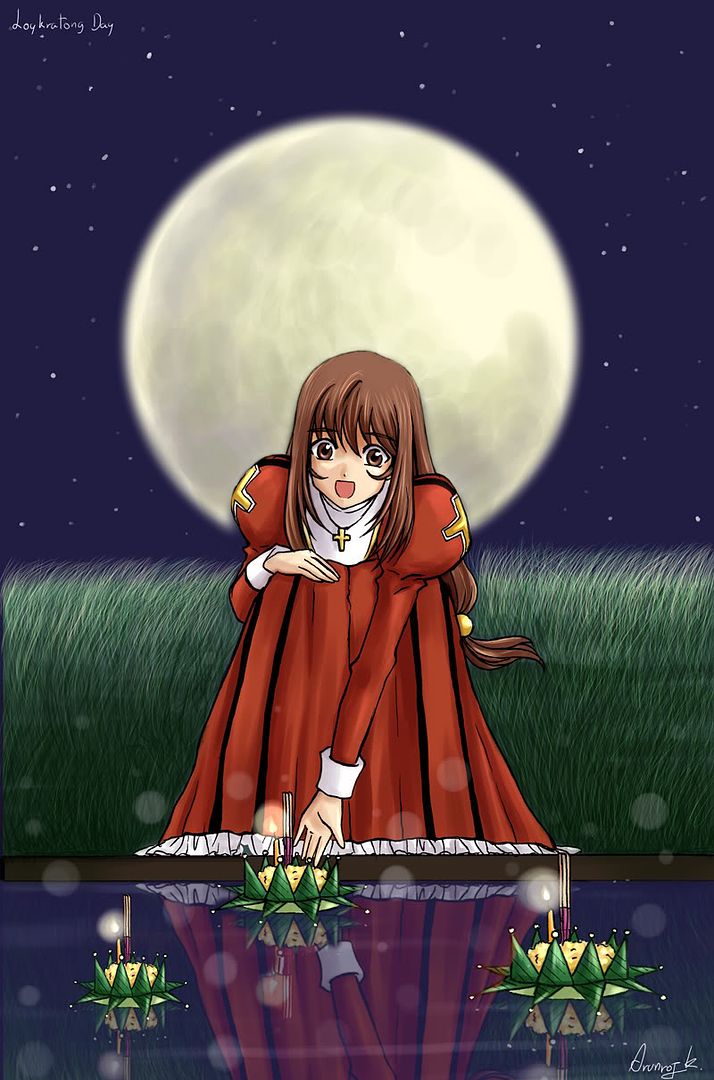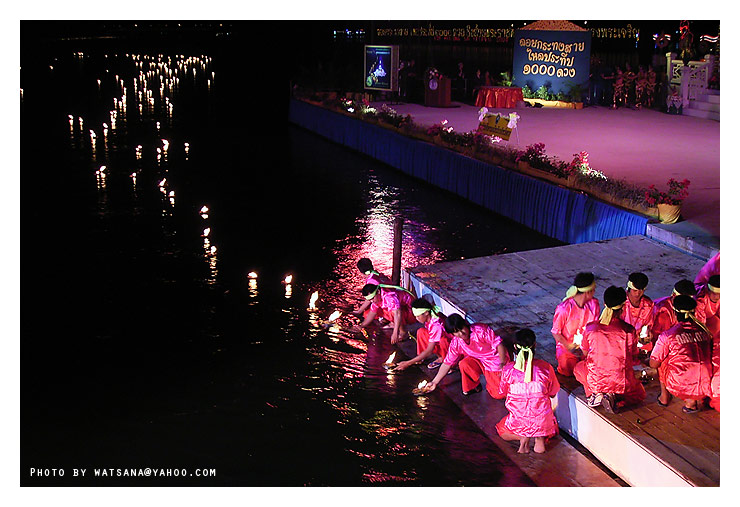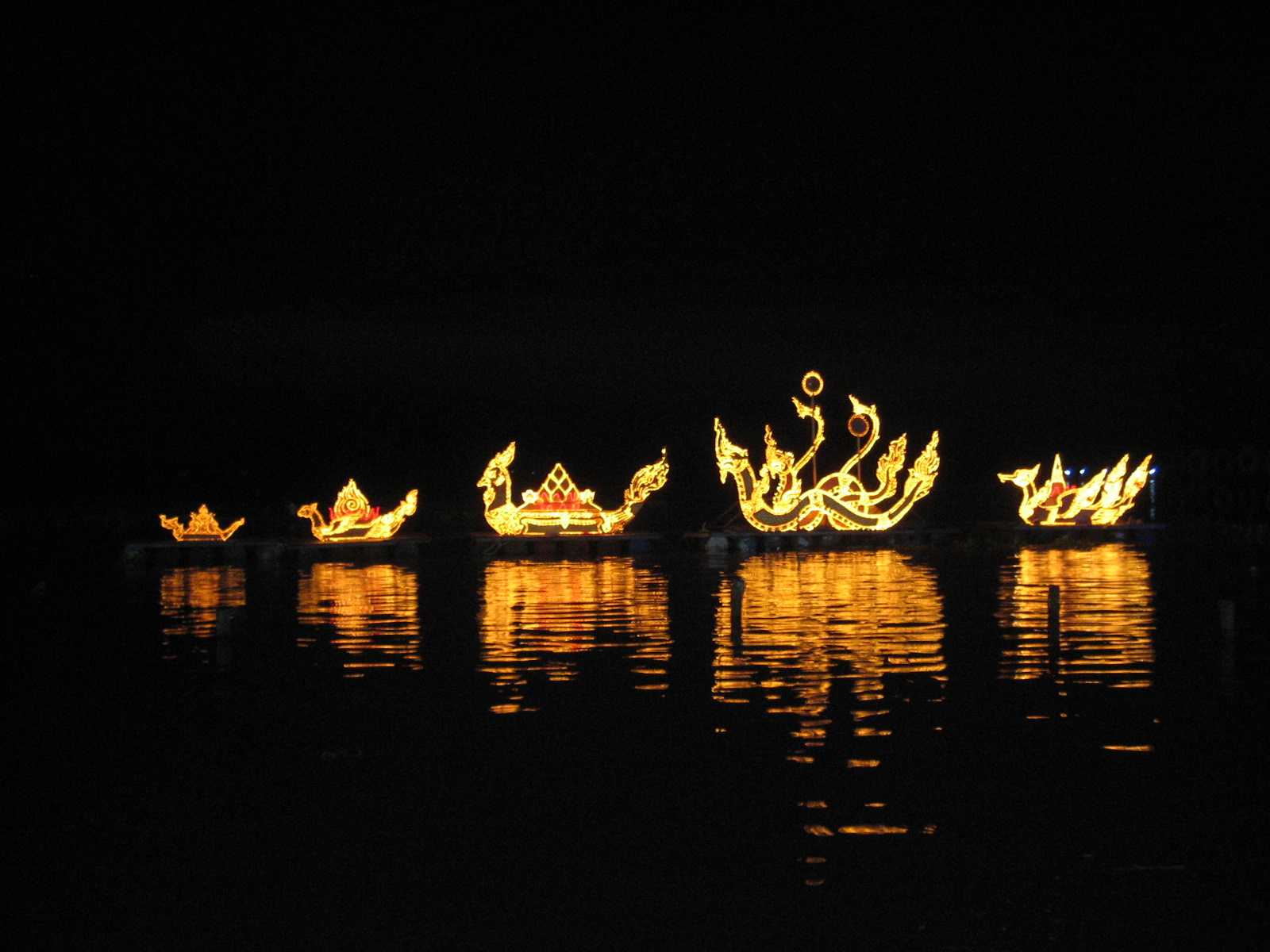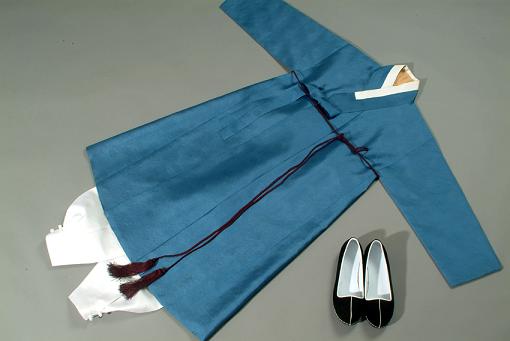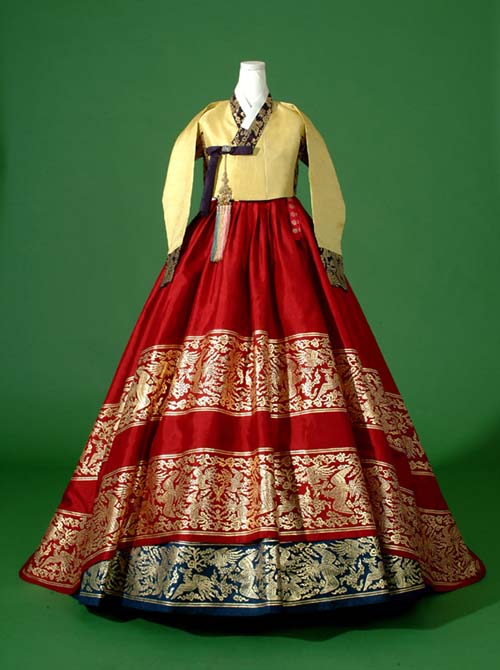
The history of Loi Krathong festival
Loi Krathong festival is a Thai tradition which has been conducted for a long time ago. Loi Krathong has been held since the middle of the eleventh to the middle of the twelfth lunar month, which is a great flood season- especially on the full moon night of the twelfth lunar month. When the moon shines at night, it makes rivers clear. It is very beautiful scenery which is suitable for floating krathong.
In the past, we called “Loi Krathong” as “Chong Pa Rieng”- floating lantern of royal ceremony. It is a Brahman festival to worship Gods- Siva, Vishnu, and Brahma. When Thai people adopted Buddhism, they adapted this ceremony to honor the Buddha’s cremated bone- the original Buddha at the second heaven ruler. They floated lantern to worship the foot-print of the Buddha on Nammathanati River beach in India.
Floating krathong along the river was created by Nang Noppamas; the most favorite concubine’s Sukhothai king. She made krathong as lotus-shaped. The king of Sukhothai floated it along the river. According to Sri Chula Luck’s treatise, Phra Ruang (Sukhothai king) said “From now on, on the full moon night of the twelfth lunar month, kings of Siam have to make floating lantern- like lotus-shaped- to worship the foot-print of the Buddha on Nammathanati River for ever after.”
In Rattanakosin period, people often made big and beautiful krathong. According to Chao Phraya Dhipharachawong’s historical annals said:-
“In the twelfth lunar month on 14 and 15 waxing moon, I ask for members of the royal family and civil servants making big-sized krathongs- look like banana trunk rafts, they size 8-9 sauk width (an ancient Thai measure of length) and 10-11 sauk tall. They make for contesting each other. For example, some imitate krathong as Mount Meru - shaped and others make krathong as basket decorated with flowers. There are a lot of people to do these so they use a lot of money- about 20 chung (an ancient measure of weight).”
Nowadays, Loi Krathong festival is held in mostly Thai provinces. Particularly in Chiangmai, it has krathong parade, contestation of making krathongs, and Noppamas beauty pageants contest.
The villagers in northern and north-eastern parts of Thailand often float lanterns. They are made of color paper. If they float in the afternoon, they will use smoke for floating lanterns while they use torch to set smoke in lanterns to float them in wind chill at night. We can see the light from lantern in the sky with moonshine and stars’ glitter at night, which is very beautiful.

歴史
ローイクラトン祭りは陰暦12月(毎年だいたい11月頃)の満月の夜に行われます。この儀式には自らの罪を洗い浄め、川の女神コンカーへ川を汚したことを謝罪するという意味があります。また、ナマダ川岸にある仏様の仏足跡を祭る儀式、ウッパクットという仏陀の偉大なる門弟へ敬意の念を捧げる為の儀式などという言い伝えもあります。ローイクラトン祭りはタイ各地の川や水路などのほとりで盛大に開催され、地方によってその趣向は様々です。
タイ国政府観光庁は11月中の観光客誘致策として「水面が七色に輝く時、ローイクラトン祭り」と題し、タイの全国各地でイベントを開催します。特に有名なのは、バンコクのローイクラトン祭り、スコータイのローイクラトン蝋燭祭り、チェンマイのイーペン祭り、タークのローイクラトンサーイ祭り、アユタヤのバンサイ芸術センターローイクラトン祭りです。この他にもローイクラトン祭り実行委員会が観光客向けの大規模なトラベルフェアを開催します。

水灯节的来历
水灯节是泰国传统节日,水灯节是从十一月中旬举行至十二月中旬,这段时间是属于丰水期 ,河水两岸都盈满着水,其中最受人民欢迎的夜晚是十二月月圆的那天,因为在这一天月亮圆满,夜晚月光照明,使河水显得清晰 ,夜景优美,适合放水灯。
古时水灯节被称为“窘扁放天灯迎神节的皇家仪式”,是婆罗门的仪式,举行此一时为了崇拜印度婆罗门之三大神有湿婆神,衲莱神,婆罗贺摩神 。当泰国人民崇拜佛教之后,就开始举办举天登仪式,为了崇敬佛骨 ,崇拜居住在天坛最高层的珠拉玛尼神,放天灯祭拜在印度“楠玛坛体”河沙滩上的佛陀足印。
在河流上放水灯,此风俗是素可泰国王“帕峦赵”之贵妃名叫“糯帕玛”设计出莲花水灯,和各型别的水灯一之供奉帕峦赵国王,让国王将水灯放到河里随着水飘流。“涛习珠拉腊”典籍里怕峦赵有句话说 “从今天开始的将来,暹罗国各个王朝程序,将规定十二月圆之夜为假日,在此日制作莲花型天灯来敬奉祭拜楠咔坛体佛陀足印直到却终。”
一旦到旧曼谷时代 (Rattanakosin時期),将创作大型舆漂亮的水灯,比如在旧曼谷时代的历史演义中,有句话说
“一旦到十二月十四,十二月十五,十二月十六(白分一日),会举行窘扁放天灯迎神节,古时将请求有驮具的内外部王族与公务员来帮忙制作大水灯,被征用的人把木材接成桶子,把芭蕉树杆做成筏 ,宽度有的八肘有的九肘,水灯最高度十至十一肘,制造出来是为了比赛,此外还有弄成“苏眉录山”,做成四洲的水灯,也有弄成一层层的扁箩,以新鲜的财物来装饰。制作水灯的人上百个,做水灯还要缴请客费和艺术师费,总共算起来二十斤,或少于二十斤(斤是古钱的单位)”
“一旦到十二月十四,十二月十五,十二月十六(白分一日),会举行窘扁放天灯迎神节,古时将请求有驮具的内外部王族与公务员来帮忙制作大水灯,被征用的人把木材接成桶子,把芭蕉树杆做成筏 ,宽度有的八肘有的九肘,水灯最高度十至十一肘,制造出来是为了比赛,此外还有弄成“苏眉录山”,做成四洲的水灯,也有弄成一层层的扁箩,以新鲜的财物来装饰。制作水灯的人上百个,做水目前,差不多每个府都在举行水灯节,算是年度隆重节日花车 ,尤其清迈府,有大小水灯花车游行活动,此外还有水灯比赛,和每年水灯选美比赛活动。还要缴请客费和艺术师费,总共算起来二十斤,或少于二十斤(斤是古钱的单位)”
对于放天灯的活动,在泰国北方与东北方仍然受老百姓的喜爱 ,老百姓将用纸制作成大型的各色天灯,若是白天放天登,将以烟火推动天灯往天上升,若是晚上放的话,就用火炬在天灯口部点火,让点燃的火冒出烟火,使天灯随着冷风流而飘走,夜晚可以欣赏明亮的天灯在空中漂流 ,欣赏月光和漂亮的星星。
-----------------------------------

Loikrathong's lyrics
November full moon shines,
Loi Krathong, Loi Krathong,
and the water's high
in the river and local klong,
Loi Loi Krathong,
Loi Loi Krathong,
Loi Krathong is here and everybody's full of cheer,
We're together at the klong,
We're together at the klong,
Each one with this krathong,
As we push away we pray,
We can see a better day.
Link for music download
http://www.loikrathong.net/download/loikrathong-en.mp3
Source : http://www.loikrathong.net/








